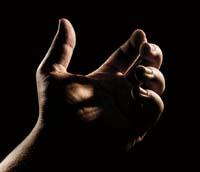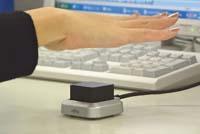Biogiltz, key for all hands

The BIOLL-Llave Biometric has been promoted by the Telecommunications, Electronics and Computer Cluster of Euskadi (GAIA) in collaboration with the University of Deusto and the company Bizgorre. This project allows to always have the key at hand. Furthermore, the hand itself is the key to this project, or at least part of it. The biometric key developed in this project is based on radiofrequency identification and on the biometric pattern of palm veins.
The biometric key is the prototype of a comprehensive access control system. They have not created new technologies, but have developed an innovative system by integrating several technologies. On the one hand, the aforementioned radiofrequency techniques have been combined with biometric techniques. However, synthesis and voice recognition technologies have also been used, and there is a possibility to manage it remotely.
Users with authorized access must register first, that is, the system must have registered the pattern of veins in the palm of the hand of these users. In addition, users will have a radio transmitter. In this way, a radio frequency receiver will inform the system of the identity of the user who wants to access the area under key. Once a user (via radio) is detected around the door, the system expects the user to put his hand on the biometric sensor.
The hand is the key
Placing your hand on the sensor (a few centimeters) is enough to open the door. It is not necessary to touch the sensor. Therefore, the system is very hygienic, suitable for installation in areas of mass use.
Once placed, the sensor scans the hand. For this purpose it emits close infrared rays and, picking up the rays reflected by the hand, gets the image of the palm of the hand. In this image the veins are clearly seen. Reduced blood hemoglobin absorbs part of the near infrared rays and, in the image taken by the sensor, the veins are seen as a black network.

The sensor will compare the pattern of veins obtained with the one registered for this user. Venous patterns have many differential characteristics and there are no two people of the same pattern, not even in the case of twins. Even the patterns of both hands are different. Therefore, whoever has registered with the right will not be able to open the door with the left. On the other hand, it is very difficult to falsify, among other things because for the sensor to get the image of the veins it is necessary to circulate blood in the veins.
Therefore, this system can be used to control access to high security areas, being able to protect their restricted areas or to increase their safety with biometric key. In addition, remote management allows organizations to easily control the access of their members.
This remote management option has the added advantage that distribution companies will be able to offer technical services to their customers in a centralized manner.
For all hands
On the other hand, the biometric key is also very useful for those people who may have difficulty using conventional keys. In fact, one of the objectives of Biogiltz is to increase the quality of life of people with disabilities and accompany them.
Among other things, for people with visual impairment and memory loss, the usual keys are great obstacles. And this new system helps these people to have a greater autonomy, since it greatly facilitates their daily activity.

When the system identifies the palm of the hand and opens the door, the voice synthesizer will indicate that the door is open. In addition, to avoid hearing problems, light indicators with the same function have been included.
In the design of the application that manages the system, people with disabilities have also been taken into account. For this reason, they have used ameno software and touch screens so that the largest number of people can use it easily.
The prototype has been visa by ONCE and is being studied in residences. The biometric key is still in test phase and those responsible for the project consider that it will be available for commercialization in 2010.





